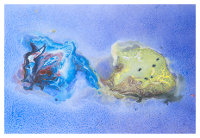Speaker
Dr
Roman Höllwieser
(NMSU/VUT)
Description
A promising picture of confinement in QCD is based on a condensate of thick vortices with fluxes in the center of the gauge group (center vortices). A number of studies of this picture have been made and specific models have been formulated to obtain a concrete realization of the vortex picture. In our model,
vortices are represented by closed random lines in 2+1- dimensional space-time. These random lines are modeled as being piece-wise linear and an ensemble is generated by Monte Carlo methods. The physical space in which the vortex lines are defined is a cube with periodic boundary conditions. Besides moving, growing
and shrinking of the vortex configuration also reconnections are allowed. Our ensemble therefore contains not a fixed, but a variable number of closed vortex lines. This is expected to be important for realizing the deconfining phase transition. Using the model, we study both vortex percolation and the potential V(R) between quark and anti-quark as a function of distance $R$ at different vortex densities, vortex segment lengths, reconnection conditions and at different temperatures. We have found three deconfinement phase transitions, as a function of density, as a function of vortex segment length, and as a function of temperature.
Author
Dr
Roman Höllwieser
(NMSU/VUT)
Co-authors
Dr
Derar Altarnaweh
(NMSU)
Dr
Michael Engelhardt
(NMSU)
